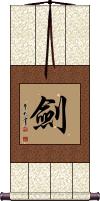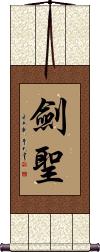Many custom options...
And formats...

劍 in Chinese / Japanese...
Buy an 劍 calligraphy wall scroll here!
Personalize your custom “劍” project by clicking the button next to your favorite “劍” title below...
1. Sword
2. Juggernaut
3. Kendo / The Way of the Sword
4. Mark the boat to find the lost sword / Ignoring the changing circumstances of the world
Sword
劍 is pronounced “jian” in Chinese. When you say it, imagine that you are making the sound of a sword as it clashes with a metal shield. This might get you closer to the correct pronunciation in Chinese.
I actually wonder if this word came from the metallic ringing sounds of a sword in battle - but such knowledge is lost in history.
The sword is a symbol of a warrior. The one thing that a soldier in ancient China lived and died by. A warrior with his skills and sword proves himself of great value. A warrior who losses his sword instantly becomes worthless.
劍 is an excellent scroll for someone in the military (especially officers of all services - as well as enlisted NCO Marines since they still carry swords even if mainly for ceremonial purposes). Or perhaps someone who practices variations of kung fu or tai chi that involve weapons.
Please note that while this character is understood with the sword meaning in Japanese, you might be looking for the word “katana” which also means sword in Japanese but means “knife” in Chinese.
There are other ways to write sword, and here are a few...
























![]()
![]()
![]()
![]()


If you are particular about the version you receive, please let me know when you place your order (Note: Special styles are only available from one of our master calligraphers).
Juggernaut
劍聖 is about the closest you can get to juggernaut in Chinese.
This more literally means “Sage of the Sword,” “Master Swordsman,” or “Sword Saint.” In Chinese terms, such a person with a divine mastery of the sword is unstoppable. Thus, the meaning of juggernaut can be derived from this term.
There is a very similar Japanese word (a slight variation on the first character) that means “Sword Saint” or “Kensei.”
Kendo / The Way of the Sword
Often associated with Kenjutsu, 剱道/劍道 means “The way of the sword” in Japanese (and Korean with an alternate form of the first character).
This is also the term used for swordsmanship and even fencing in Japanese and Korean, depending on context.
Note: These same characters are also used separately in Chinese, but this exact combination yields a common title in Japanese only (perhaps someone who is really into swords would use this in China).
Note: There is more than one way to write the “sword” character (shown above is the Japanese version - if you want the Korean version, please let me know when you place your order).
Mark the boat to find the lost sword / Ignoring the changing circumstances of the world
刻舟求劍 is an originally-Chinese proverb that serves as a warning to people that things are always in a state of change.
Thus, you must consider that and not depend on the old ways or a way that may have worked in the past but is no longer valid.
This idiom/proverb comes from the following story:
A man was traveling in a ferry boat across a river. With him, he carried a treasured sword. Along the way, the man became overwhelmed and intoxicated by the beautiful view and accidentally dropped his prized sword into the river. Thinking quickly, he pulled out a knife and marked on the rail of the boat where exactly he had lost his sword.
When the boat arrived on the other side of the river, the man jumped out of the boat and searched for his sword right under where he'd made the mark. Of course, the boat had moved a great distance since he made the mark, and thus, he could not find the sword.
While this man may seem foolhardy, we must take a great lesson from this parable: Circumstances change, so one should use methods to handle the change. In modern China, this is used in business to mean that one should not depend on old business models for a changing market.
This proverb dates back to the Spring and Autumn period (770–476 BC) of the territory now known as China. It has spread and is somewhat known in Japan and Korea.
Haidong Gumdo
海東劍道 is the Korean martial arts style that means Eastern Sea Sword Way.
The character meanings break down this way:
海 = Sea
東 = East/Eastern
劍 = Sword
道 = Way/Path/Style/Method
This can sometimes be romanized as “Hae Dong Kum Do,” “Haidong Kendo,” “Hae Dong Geom Do,” “Haedong Geomdo,” or “Haedong Kumdo.”
If you want this written in modern Korean Hangul (해동검도) instead of Hanja (Chinese), click on the Hangul characters next to the Korean flag above, instead of the regular button.
Energy Sword Body in Concert
Spirit, Sword & Body as One
气剑体一致 often gets translated as “Mind Sword Body,” or “Spirit, Sword, and Body as One.” But I think these translations don't tell you enough about what this is really saying.
In this context, 気, which is the modern Japanese version of 氣, means spiritual and unseen energy or “life energy.” In some cases, 気 can be translated as spirit, feeling, or nature. If defined as the mind, it's more about the invisible or intangible parts of one's mind (or soul).
剣 is the Japanese version of 劍 meaning sword.
体 is the modern Japanese version of 體 meaning body.
The Kanji 一 means one, and in this case, suggests “all in one.”
The Kanji 到 means to send, deliver, or convey. But together, 一到 suggests all these things in agreement, union cooperation, or in concert.
Note: Arguments exist as to whether this should be romanized as Kikentaiitchi, Kikentaiicchi, or kikentaiichi. Technically, if you drop the last character, you get 気剣体一 and kikentaiichi (ki ken tai ichi), which is also a valid phrase.
Not the results for 劍 that you were looking for?
Below are some entries from our dictionary that may match your 劍 search...
| Characters If shown, 2nd row is Simp. Chinese |
Pronunciation Romanization |
Simple Dictionary Definition |
劍 剑 see styles |
jiàn jian4 chien ken つるぎ |
More info & calligraphy: Sword(out-dated kanji) sword (originally esp. a doubled-edged sword); sabre; saber; blade; (out-dated kanji) (1) sword (originally esp. a doubled-edged sword); sabre; saber; blade; (2) bayonet; (3) swordsmanship; (4) stinger; ovipositor; dart A sword, a two-edged sword.; A sword, two-edged sword. |
刻舟求劍 刻舟求剑 see styles |
kè zhōu qiú jiàn ke4 zhou1 qiu2 jian4 k`o chou ch`iu chien ko chou chiu chien |
More info & calligraphy: Mark the boat to find the lost sword / Ignoring the changing circumstances of the world |
佩劍 佩剑 see styles |
pèi jiàn pei4 jian4 p`ei chien pei chien |
sword; (fencing) saber |
六劍 六剑 see styles |
liù jiàn liu4 jian4 liu chien rokken |
六箭 The six swords (or arrows), i. e. the six senses, v. 六塵, which are defined as the qualities of sight, sound, smell, taste, touch, and mind. |
刀劍 刀剑 see styles |
dāo jiàn dao1 jian4 tao chien |
sword |
利劍 利剑 see styles |
lì jiàn li4 jian4 li chien riken |
sharp sword A sharp sword, used figuratively for Amitābha, and Mañjuśrī, indicating wisdom, discrimination, or power over evil. |
劍客 剑客 see styles |
jiàn kè jian4 ke4 chien k`o chien ko |
swordsman |
劍尖 剑尖 see styles |
jiàn jiān jian4 jian1 chien chien |
point; sharp end |
劍山 剑山 see styles |
jiàn shān jian4 shan1 chien shan kensan |
劍樹地獄 Asipattra. The hill of swords, or sword-leaf trees hell, one of the sixteen hells; also called 刀刃路. |
劍川 剑川 see styles |
jiàn chuān jian4 chuan1 chien ch`uan chien chuan |
Jianchuan county in Dali Bai autonomous prefecture 大理白族自治州[Da4 li3 Bai2 zu2 zi4 zhi4 zhou1], Yunnan |
劍持 see styles |
kenmochi けんもち |
(surname) Kenmochi |
劍柄 剑柄 see styles |
jiàn bǐng jian4 bing3 chien ping |
sword hilt |
劍標 剑标 see styles |
jiàn biāo jian4 biao1 chien piao |
(typography) dagger (†) |
劍橋 剑桥 see styles |
jiàn qiáo jian4 qiao2 chien ch`iao chien chiao |
Cambridge |
劍河 剑河 see styles |
jiàn hé jian4 he2 chien ho |
Jianhe county in Qiandongnan Miao and Dong autonomous prefecture 黔東南州|黔东南州[Qian2 dong1 nan2 zhou1], Guizhou |
劍法 剑法 see styles |
jiàn fǎ jian4 fa3 chien fa |
fencing; sword-play |
劍波 剑波 see styles |
jiàn bō jian4 bo1 chien po Kenpa |
Kampa, Bhūkampa; deva of earthquakes. |
劍蒲 剑蒲 see styles |
jiàn pú jian4 pu2 chien p`u chien pu Kenbo |
Kamboja |
劍術 剑术 see styles |
jiàn shù jian4 shu4 chien shu |
swordsmanship |
劍身 剑身 see styles |
jiàn shēn jian4 shen1 chien shen |
sword blade |
劍道 剑道 see styles |
jiàn dào jian4 dao4 chien tao |
kendō (sports) |
劍閣 剑阁 see styles |
jiàn gé jian4 ge2 chien ko |
Jiange county in Guangyuan 廣元|广元[Guang3 yuan2], Sichuan |
劍魚 剑鱼 see styles |
jiàn yú jian4 yu2 chien yü |
swordfish |
劍鴴 剑鸻 see styles |
jiàn héng jian4 heng2 chien heng |
(bird species of China) common ringed plover (Charadrius hiaticula) |
劍麻 剑麻 see styles |
jiàn má jian4 ma2 chien ma |
sisal hemp |
劍龍 剑龙 see styles |
jiàn lóng jian4 long2 chien lung kenryuu / kenryu けんりゅう |
stegosaurus (surname) Kenryū |
寶劍 宝剑 see styles |
bǎo jiàn bao3 jian4 pao chien |
(double-edged) sword; CL:把[ba3],方[fang1] |
心劍 心剑 see styles |
xīn jiàn xin1 jian4 hsin chien shinken |
sword of the mind |
慧劍 慧剑 see styles |
huì jiàn hui4 jian4 hui chien eken |
The sword of wisdom which cuts away illusion. |
拔劍 拔剑 see styles |
bá jiàn ba2 jian4 pa chien bakken |
draws one's sword |
Click here for more 劍 results from our dictionary
The following table may be helpful for those studying Chinese or Japanese...
| Title | Characters | Romaji (Romanized Japanese) | Various forms of Romanized Chinese | |
| Sword | 劍 剑 | ken / tsurugi | jiàn / jian4 / jian | chien |
| Juggernaut | 劍聖 剑圣 | jiàn shèng jian4 sheng4 jian sheng jiansheng | chien sheng chiensheng |
|
| Kendo The Way of the Sword | 剱道 / 劍道 剣道 | kendou / kendo | jiàn dào / jian4 dao4 / jian dao / jiandao | chien tao / chientao |
| Mark the boat to find the lost sword Ignoring the changing circumstances of the world | 刻舟求劍 刻舟求剑 | kokushuukyuuken kokushukyuken | kè zhōu qiú jiàn ke4 zhou1 qiu2 jian4 ke zhou qiu jian kezhouqiujian | k`o chou ch`iu chien kochouchiuchien ko chou chiu chien |
| Haidong Gumdo | 海東劍道 海东剑道 | hǎi dǒng jiàn dào hai3 dong3 jian4 dao4 hai dong jian dao haidongjiandao | hai tung chien tao haitungchientao |
|
| Energy Sword Body in Concert | 気剣体一致 / 氣劍體一致 气剑体一致 | ki ken tai icchi kikentaiicchi ki ken tai ichi | ||
| In some entries above you will see that characters have different versions above and below a line. In these cases, the characters above the line are Traditional Chinese, while the ones below are Simplified Chinese. | ||||
Successful Chinese Character and Japanese Kanji calligraphy searches within the last few hours...









